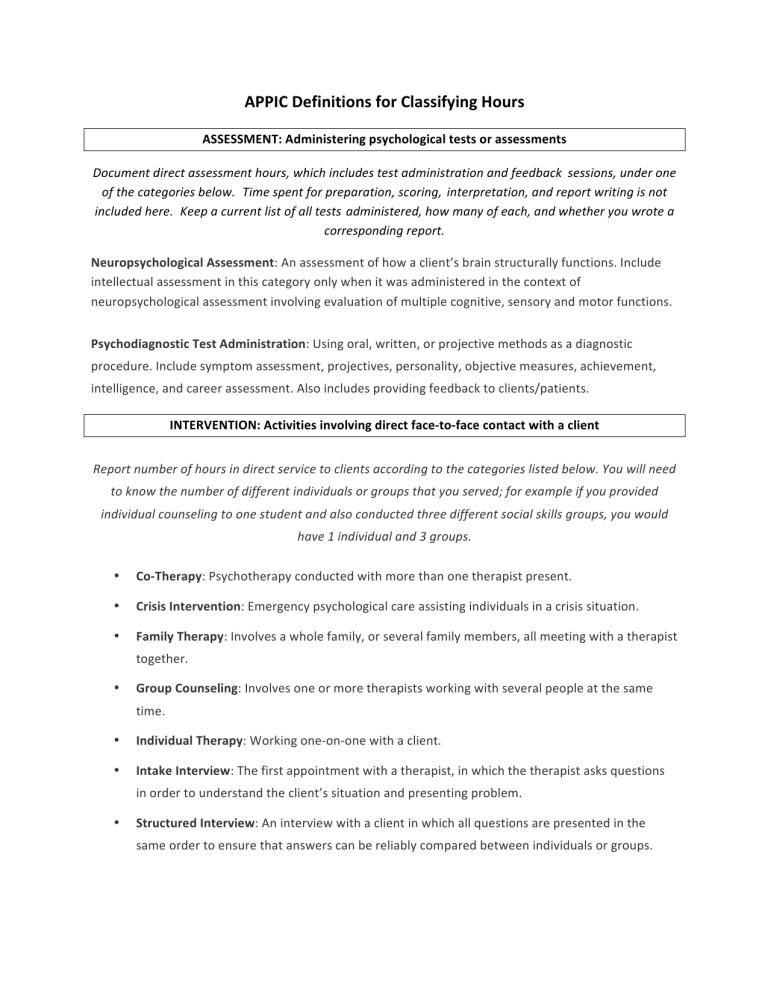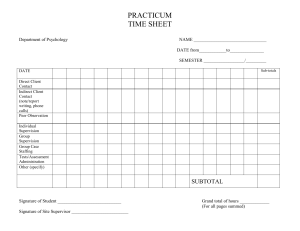
APPIC Definitions for Classifying Hours ASSESSMENT: Administering psychological tests or assessments Document direct assessment hours, which includes test administration and feedback sessions, under one of the categories below. Time spent for preparation, scoring, interpretation, and report writing is not included here. Keep a current list of all tests administered, how many of each, and whether you wrote a corresponding report. Neuropsychological Assessment: An assessment of how a client’s brain structurally functions. Include intellectual assessment in this category only when it was administered in the context of neuropsychological assessment involving evaluation of multiple cognitive, sensory and motor functions. Psychodiagnostic Test Administration: Using oral, written, or projective methods as a diagnostic procedure. Include symptom assessment, projectives, personality, objective measures, achievement, intelligence, and career assessment. Also includes providing feedback to clients/patients. INTERVENTION: Activities involving direct face-to-face contact with a client Report number of hours in direct service to clients according to the categories listed below. You will need to know the number of different individuals or groups that you served; for example if you provided individual counseling to one student and also conducted three different social skills groups, you would have 1 individual and 3 groups. • Co-Therapy: Psychotherapy conducted with more than one therapist present. • Crisis Intervention: Emergency psychological care assisting individuals in a crisis situation. • Family Therapy: Involves a whole family, or several family members, all meeting with a therapist together. • Group Counseling: Involves one or more therapists working with several people at the same time. • Individual Therapy: Working one-on-one with a client. • Intake Interview: The first appointment with a therapist, in which the therapist asks questions in order to understand the client’s situation and presenting problem. • Structured Interview: An interview with a client in which all questions are presented in the same order to ensure that answers can be reliably compared between individuals or groups. • Outcome Assessment of Programs or Projects: Assessing the outcome of any programs or projects. • Program Development / Outreach Programming: Create and offer programs or outreach activities designed for the education and prevention of psychological concerns. • School (Direct Intervention): A direct intervention in a school setting. • School Consultation: Interview to assess the client, their needs, and goals for treatment in a school setting. • Supervision of Other Students: Supervising other students. • Systems Intervention / Organizational Consultation / Performance Improvement • Systems Intervention: Eliminate system limitations by prioritizing needs, specify outcomes, and design an intervention program. • Organizational Consultation / Performance Improvement: Consult with an organization in order to improve the performance and well-being of its employees. • Treatment Planning with Client: Planning a course of treatment with a client. SUPPORT: Activities involving indirect, or non-face-to-face contact with a client Record number of hours of indirect service, which includes: chart/record review, test scoring, writing reports or progress notes, planning interventions, consulting with others about cases (client is not present), video/audiotape review, didactic instruction (e.g., grand rounds, seminar). These hours do not need to be categorized, but you may want to be specific in your log in case the information is requested at a later date. • Assessment Report Writing: Writing reports on administered assessments. • Case Conferences: Bring together key parties in order to mutually agree upon goals and strategies to achieve them. • Case Management: A collaborative process of assessment, care planning, facilitation, and advocacy for options and services to meet an individual’s mental health needs. • Clinical Writing / Progress Notes: Writing treatment progress notes, or other clinical writing. • Coordinate Community Resources: Assisting a client in locating and/or securing community resources. • Observation: Observing other trained individuals perform therapeutic activities. • Professional Consultation: Consulting with another professional regarding a case or client. • Psychological Assessment Scoring / Interpretation: Scoring and/or interpreting psychological assessments. • Seminars / Didactic Training: Any training involving seminars or lectures. • Video-Audio-Digital Recording Review: Reviewing video or audio recordings. Supervision In this section, you will document the amount of time that you have spent receiving supervision. For the purposes of this section, supervision can be provided by licensed psychologists, licensed allied mental health providers (e.g., social workers, marriage and family therapists, psychiatrists), and advanced doctoral students whose supervision is supervised by a licensed psychologist. Supervision activity involves a formal evaluative component, and may include both supervision received as an individual (i.e., one-to-one) and within a group. Supervision that you have provided to less advanced students should not be recorded in this section, and may instead be included in the “Intervention Experience” section. Three categories of supervision are identified. Supervision is differentiated by a focus on specific cases, with the intent of overseeing those cases. 1. Regularly scheduled, individual, face-to-face supervision - Individual supervision is defined as regularly scheduled, one-on-one, face-to-face supervision with the specific intent of overseeing the psychological services rendered by the supervisee. 2. Group supervision (seminar time spent in case discussion) - Group supervision is defined as regularly scheduled, face-to-face supervision with multiple supervisees, with the specific intent of overseeing the psychological services rendered by the supervisees. 3. Peer supervision **Many excellent practicum courses incorporate both didactic and experiential components in the course activity. While the didactic portion is excellent training, it should not be recorded as a supervision activity; it should instead be record in the “Support Activities” section. This may necessitate dividing the hours spent in a practicum course into intervention, supervision, and didactic activities by actual course hours. For example, if you present on the “Psychosocial Issues of HIV Infection” using examples of cases, it is a didactic activity. Similarly, Grand Rounds that consist of in-service education on specific topics would not be considered supervision, but would be considered a support activity. Treatment Settings In another section of the AAPI Online (“Intervention Experience”), you will be asked to summarize your practicum experience by population and type of intervention. In this section, you will summarize that same practicum experience by the setting in which it occurred. You should include only those hours that qualify as practicum experience and involve either assessment or intervention. “Qualified practicum experience” is that which has been formally sanctioned by your graduate program. Diverse Populations / Client and Setting Characteristics In addition to logging number of hours engaged in assessment/intervention, support, and supervision activities, you need to keep a record of the following. 1. age of client 2. gender (male/female/transgendered) 3. race/ethnicity 4. disability/diagnosis (physical/orthopedic, vision, hearing, learning/cognitive, developmental disability, serious mental illness which includes severe developmental disability, other – specify); may include more than 1 designation In this section, you should specify your practicum experience with diverse populations in a professional therapy/counseling/assessment capacity. Indicate the number of clients seen for assessment and intervention for each of the diverse populations listed. You may not have information for some of your clients/patients on some of the items, so only indicate the information that is known. Include under the assessment column those clients/patients for whom you performed assessments and/or intake interviews. For this section, you may include a single client/patient in more than one category and/or more than one column, as appropriate. For families, couples, and groups, please count each individual as a separate client/patient. 1. 2. 3. 4. 5. 6. 7. Additional Notes on APPIC Requirements A practicum hour is actual time, not semester hour; a 45-50 minute session can be counted as a full hour. Practicum hours are mutually exclusive – you may not count an activity under more than one category (assessment/intervention, support, or supervision). Practicum is defined as formal training sanctioned by the University program for which you receive academic credit and supervision. Other clinical or professional experience may be documented in a manner similar to but separate from practicum hours. In listing specific tests administered, you may combine numbers from practicum, work, and research experiences (but not practice administrations). In addition to number of reports written for specific tests administered, APPIC asks for the number of integrated reports written, which includes: history, interview, and at least two tests administered. Teaching experiences also may be documented. For Additional Information about Assessment or Intervention Hours Documentation, Please See: Assessment: https://portal.appicas.org/applicants2012/instruction/ins_psya_exp.htm Intervention: https://portal.appicas.org/applicants2012/instruction/ins_exp_intervention.htm



